Species from adjacent areas within the Guayana Region are also included or listed if they are believed to occur in the Guianas. The largest subfamily in the Guianas (excluding cultivated genera and species) is the Acalyphoideae (17 genera, 54 species), followed by the Crotonoideae (1.1 genera, 50 species), Euphorbioideae (1.1 genera, 35 species), Phyllanthoideae (8 genera, 3 1 species) and Oldfieldioideae (1 genus, 1 species). In addition, the genus Acidoton, known from the neighboring state of Bolivar, Venezuela, can be expected to occur in the Guianas and is included in the key to the genera.
In the Guianas, necklaces were apparently made from small polished fragments of the hard seed coat (Duss, . 1897). This method of climbing contrasts with the much more typical method of all other Euphorbiaceae vines and lianas in Guyana (e.g. Dalechampia spp., Plukenetia and Tragia). Flowering from September to November, fruiting from February to April has been reported in the Guyana.
Intraspecific variation in the density of stellate hairs on the lower surface of the leaf blade may be responsible for some of the confusion described above.
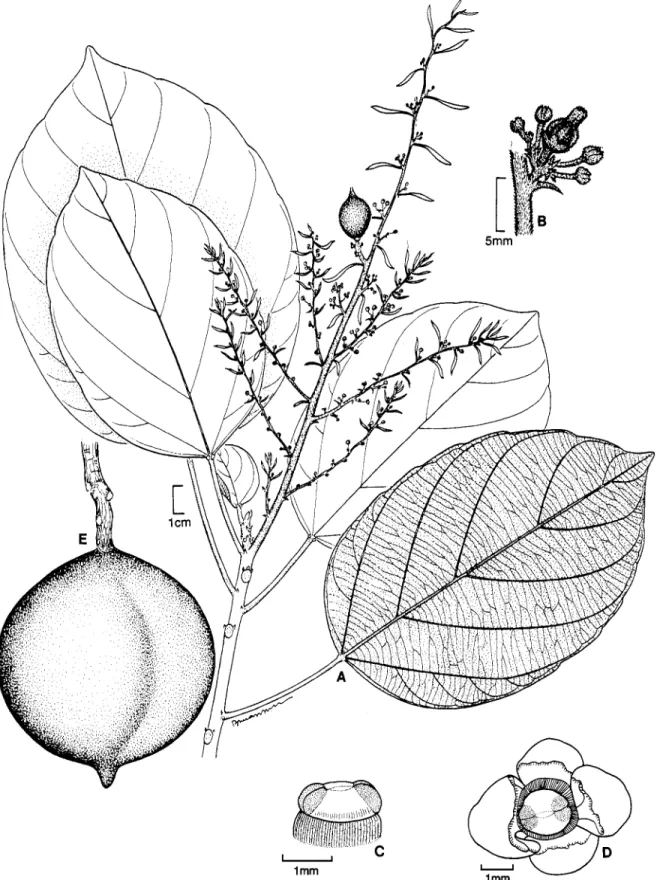
Pera glabrata (Schott) Baill
Shrubs; leaves pinnately veined; convoluted bracts pink (rarely yellowish) at the flower opening; inflorescence glands yellow or greenish, surface papillary, with a spicy odor. 5 Involucral bracts spatulate, 5-8 mm long, 3-4 mm wide, deciduous before fruiting; stamens involucellar bracts free, 4 in number; surface of stigmas papillary. Leaves unlobed; convoluted bracts undersized, inconspicuous, small (C6 mm long), stipuliform, green at anthesis or dimorphic (one small, the other conspicuous, >1 cm long, whitish); inflorescence gland usually absent; pistil sepals 6, unlobed.
Involucral bracts usually double, those with pistillate flowers >1 cm long, whitish, those descending with fertile flowers <5 mm long, stipuliform, green; stigmatic surface extending from tip to w2/3 length of style. 16 Pleiochasium staminata with 4 free bracts; inflorescence gland comprising concentrically arranged bracts with lacquered margins exuding a greenish or brownish resin; sheathing leaves striped and green or ovate and pink. Leaf plates 7-27 cm long with brownish pubescence below, sheathing leaflets green near the inflorescence, 1-2 cm long, inflorescence gland secretes bluish-green resin, shape more or less uniformly columnar, pistillate sepals 6, without lobes, fruit 3.5 -4 cm in diameter.
Involucral bracts white near flowers, >3 cm long, entire or shallowly 3-lobed, with 7-9 prominent veins; floral gland secreting a yellowish resin; tips of styles widely spread and symmetrically peltate. 2 their length, with 5 prominent veins; floral gland secreting a clear to whitish resin; tips of styles sparingly and asymmetrically expanded. Leaflets ovate to lanceolate-ovate, persistent; sheathing bracts 3-lobed to -*/2 their length, C3.5 cm long at anthesis, with 5 prominent veins; floral gland secreting a clear to whitish resin.
18 Leaf stipules lance-ovate to lance-linear, deciduous; involucral bracts shallowly 3-toothed at apex, >3 cm long at anthesis, with 7–9 prominent veins; inflorescence 18. Young stems and petioles with sparse to moderately densely scattered straw-colored pubescence; underside of mature leaves smooth to strigulose; involucral bracts pale green to whitish, margins with small fimbriae, these at most weakly capitate, c0.5 mm long; margin of proximal bracts of pistillate involucel entire; stylish. scandens Young stems and petioles with very densely scattered orange pubescence; underside of mature leaves lanate; involucral bracts white, margins with strongly capitate tentacular processes, generally 1-1.5 mm long; margins of proximal bracts of pistillate involucel capitate glandular; stylar column with broadly expanded 19. Leaf stipules lance-linear; involucral bracts whitish cream at anthesis; inflorescence Petioles lanceolate-ovate to lanceolate; involucral bracts pale green at anthesis;. brownsbergensis dentate, but without glandular appendages secreting sticky resin. gland inconspicuous or exuding yellowish resin. column with slightly and asymmetrically expanded tip. fallax gland prominent, secretes yellowish resin. tiliifolia inflorescence gland inconspicuous and vestigial, does not secrete resin.
Dalechampia attenuistylus Armbruster
Dalechampia brevicolumna Arm b rus ter
Dalechampia brownsbergensis Webster
Dalechampia heterobractea Armbruster
Dalechampia megacarpa Armbruster
NOTES.-This species has only been found in Guayanan and Amazonian Venezuela and Amazonian Brazil, but almost certainly occurs in Guyana.
Dalechampia micrantha Poepp
Dalechampia olympiana Kuhlman & Rodrigues
Dalechampia papillistigma Armbruster
EXOMES EXAMINED.-Venezuela: Santa Elena de Uairen, NOTES.-Not closely related to any other species that we 4"37'N, 6lo7'W, Armbruster et al.
Dalechampia parvibracteata Lanj
Dalechampia scandens L
C C W S in southern Guyana and perhaps eastern Brazil (see "Notes" below); studied two collections, both from Guyana. SPECIMENS EXAMINED.4Uyana: Upper Takutu-Upper Essequibo region, 5 km NNE of Dadanawa, Gillespie 19.55 (ALA); at Rupununi River, Turukwan, Rupununi, Cook 44 NOTES.-This taxon differs from D. 6-14 cm, apex of each lobe narrowly acute, leaf base deeply cordate, sparsely hairy above and below, margins usually glandular; stipules lanceolate-ovate, 10-20 x.
Inflorescence pseudantial; the two bracts involucral, pale green at anthesis, broadly ovate, apex deeply 3-lobed, 4-6 x 2-4 cm, sparsely pubescent, the margins usually glandular; resin gland secretes yellow resin. Locally distributed in French Guiana, hitherto known only from the Saul area; 15 collections examined, including two from French Guiana. ECOLOGY .-In open areas, including secondary vegetation and edges of moist to wet forest, below 1000 m altitude.
The flowers were collected in August and June in French Guiana; it seems to bloom year-round in Venezuela. SPECIMENS EXAMINED.-French Guiana: Route de Belizon between Eaux Claires and the entrance to the Boeuf-Mort route, Mori et al. NOTES.-This species is characteristic of the Guiana region in having stipules, bracts, and leaves with strongly capitate glandular margins.
Dalechampia stipulacea has only recently been collected from Guiana, from only a small area near Saul, French Guiana. Widespread in unforested parts of the Guianas; 50 collections studied, of which 33 are from Guyana (G:l, FG:32). Flowers in the dry season in Mesoamerica; flowers collected in Guiana throughout the year; h i t is mainly from March to June.
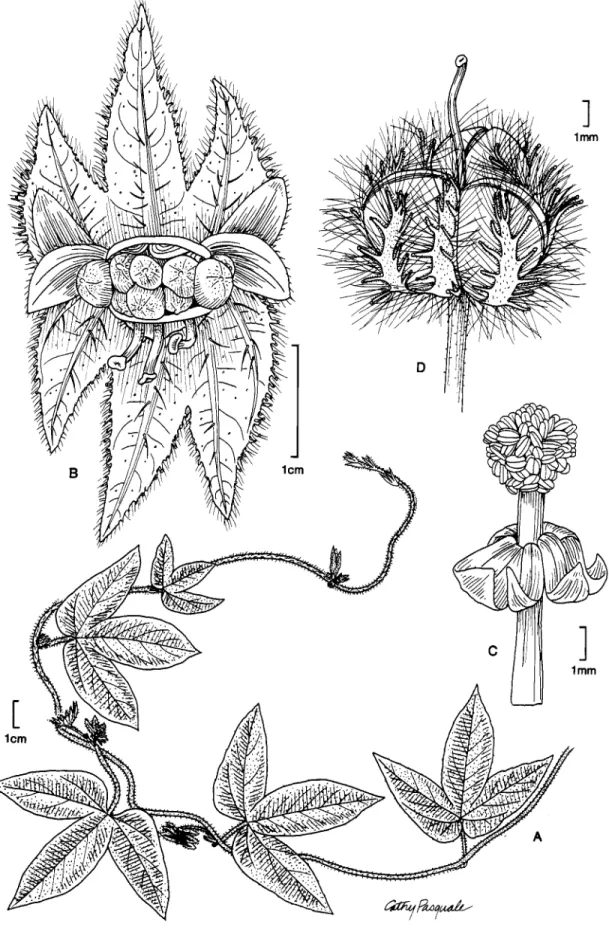
Dalechampia aff. cissifolia Poepp
Pistillate flowers with calyx of 10-13 sepals, these pinnate, densely hispid; pistil with elongated stylar column, 6-12 mm long, tip asymmetrically dilated to umbraculiform. Fruit a capsule, surface thin to densely ruddy; seeds spherical, brown and gray spotted, -5 mm in diameter, surface smooth. The inflorescence glands secrete yellow resin that is collected by pollinating female euglossine bees (Eulaema, Euglossa) (Armbruster and Herzig, 1984).
Dalechampia aff. triphylla Lam
Stipe 1-2.5 mm long, densely pubescent; sepals oblong-lanceolate, -1.5 mm long, outer surface sparsely pubescent; ovary distinctly 3-lobed, -0.8 x 1.5-2 mm, densely wrinkled, glabrous; stylar column oblong-obovoid, 2.5-3.5 x -2 mm, truncate at apex with broad lobes bearing horn-like papillae on margins. Petiole 0.5-2 cm long, pendulous; leaflet yellowish, elliptic x 3-7(-9) cm, apex acuminate, base acute to obtuse and shortly longitudinal, margin serrate, glabrous to sparsely pubescent on larger veins above and below, pinnately veined; basilaminar glands 2-4 pairs, round, -1 mm diam., or sometimes confluent into a single oblong pair, -3 mm long, on lateral bases of leaves; scattered laminar glands round, -0.5 mm wide, near margin. Staminate pedicel 4-8 mm long, tomentose; bud subglobose, -1.5 mm long, apex obtuse; sepals 4, ovate-elliptic, 2-2.5 mm long, sparsely pubescent; stamens 15-25, sessile on a round receptacle.
Inflorescences axillary, racemose or sometimes paniculate, usually unisexual, ax puberulous; staminate inflorescence 5-25 (rarely up to 35) cm long, flowers numerous on scorpoid or digasial-scorpoid cymose lateral branches 0.2-2 cm long, pistillate flowers sometimes occurring at basal-mostly 1-2 nodes on an otherwise staminate inflorescence; pistillate inflorescence 1.5-3 (rarely to 7) cm long, flowers 3-4(-lo), 1 or rarely 2 per lateral cimetac, these 1-3 mm long; bracts triangular, -1 mm long, apex acute. Stamina pedicel 2-4 mm long; bud narrowly oblong-ellipsoid or oblong-ellipsoid, -3 mm long, apex acute;. Pistillate pedicel 0.5-1 mm long, glabrous to sparsely puberulent; sepals 4, triangular, 0.5-1 mm long, glabrous, appressed to the ovary; ovary 4-angled, -1.5 x 2 mm, not distinctly winged or lobed, glabrous; styles connate in a narrow-conical column, 3-7 mm long, free at apex, arms 1.5-2.5 mm long, divergent.
Staminate peduncle 3.5-4.5 cm long, densely puberulous; bud subglobose, -1 mm long or less, apex rounded or broadly obtuse; sepals 4, elliptic, 1-1.3 mm long, apex acute and thickened, twisted; disc 4-lobed, located between the outer anther whorl and the inner anther cluster; Inflorescence axillary, terminal on a short shoot, 1-4 cm long, or terminal and apparently opposite the leaves, racemose, 0.5-4 cm long, axes tomentose; pistillate flower single at base, staminate flowers numerous in dense cymes above; leaflets triangular, 0.5-1 mm long, pubescent. Staminate peduncle 2-4.5 mm long, pubescent; bud globose, 1 - 1.4 mm in diameter; sepals 4, ovate, -1 mm long, apex acute; annular disc between outer anther whorl and inner stamens; androecium with 6-10 sessile stamens on a strong cylindrical insert and 4.
4-lo(-18) cm, top long pointed with a 1-2 cm long point, base truncate to cordate, glabrous below, 3 veins at base; basilaminar glands paired, round to laterally oblong, 1.5-3 mm wide, usually with a small knob between; scattered laminar glands absent. Inflorescence axillary or terminal on a short shoot, racemose, 5-18 cm long, axes sparsely to moderately pubescent; pistillate flower(s) 1 or rarely 2 at basal node(s), many staminate flowers in condensed cymes above; leaflets narrowly triangular, 1.5-2.5 mm long. Staminate peduncle 2-3 mm long; bud subglobose, -2 mm long, tip rounded to obtuse; sepals 4, ovate-elliptic, -2 mm long, apex acute, glabrous; disc absent; stamens on a convex receptacle; filaments -0.5 mm long, expanded at base, attenuate at apex.
Inflorescence terminal consisting of a main staminate axis with a single pistillate basal branch; peduncle 1-3 cm long, lengthens to 6.5 cm in fruit; staminal axis racemose, 1.5-7 cm long; pistillate axis racemose, 2.5-7 cm long, lengthens to 17 cm in fruit; bracts lanceolate, tip compressed, bracts tyschen -2 mm long, pistillate bracts 3-4 mm long; Pistillate peduncle -1 mm long, puberulous, pubescent at apex, with glandular hairs along margin; sepals 6, lanceolate, -2 mm long, with urticulate and glandular hairs; ovary 3-lobed, -1 x 1.8 mm, densely pubescent with urticulate and glandular hairs; pieces 2.5-3.5 mm long, connected about two-thirds of the length, arms curved.
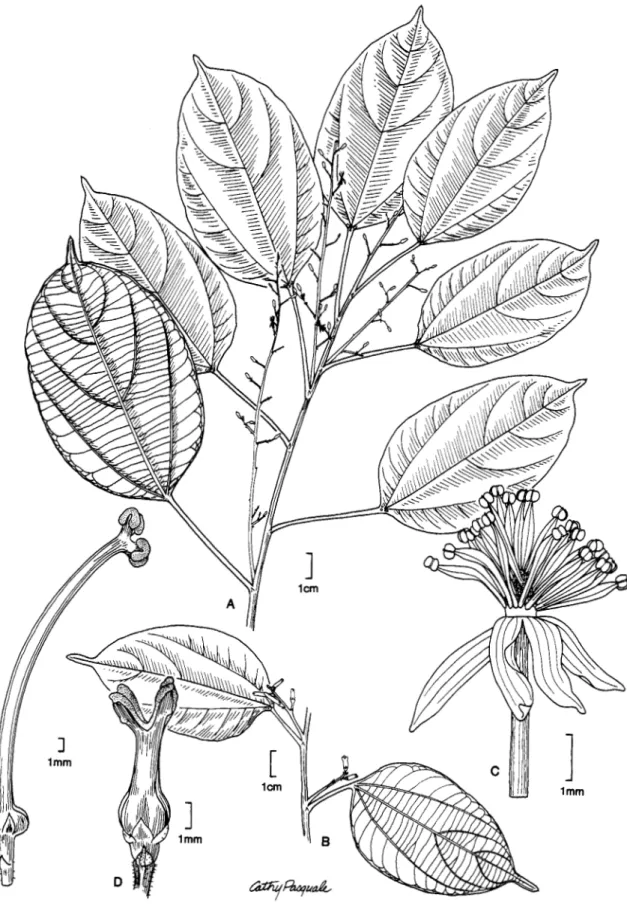
Tragia volubilis L
Inflorescence terminal on short shoots or leaf-opposite appearance, racemose, 4-9 cm long, ax puberulous with numerous long-stipitate glandular hairs and scattered short urticating hairs; single pistillate flower at basal node, staminate flowers numerous above, 1 per node;. Fruiting pedicel 2-6 mm long; sepals persistent, reflexed; capsule 3-lobed, -4.5 x 7-8 mm, sparsely covered with urticating hairs and sometimes glandular hairs;. Evolution, main pollinators of Dalechampia species, with location of study sites and study dates.
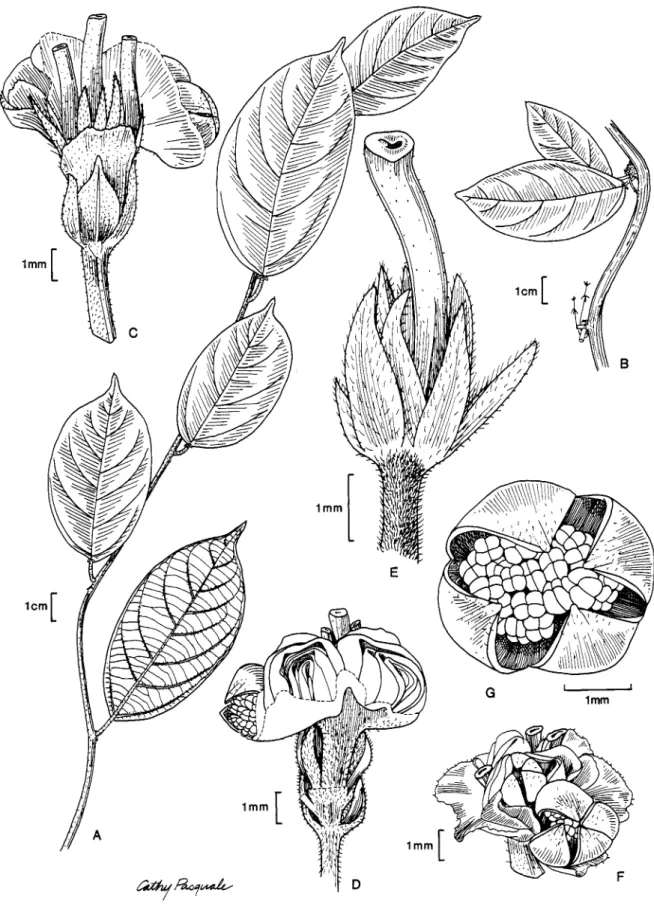
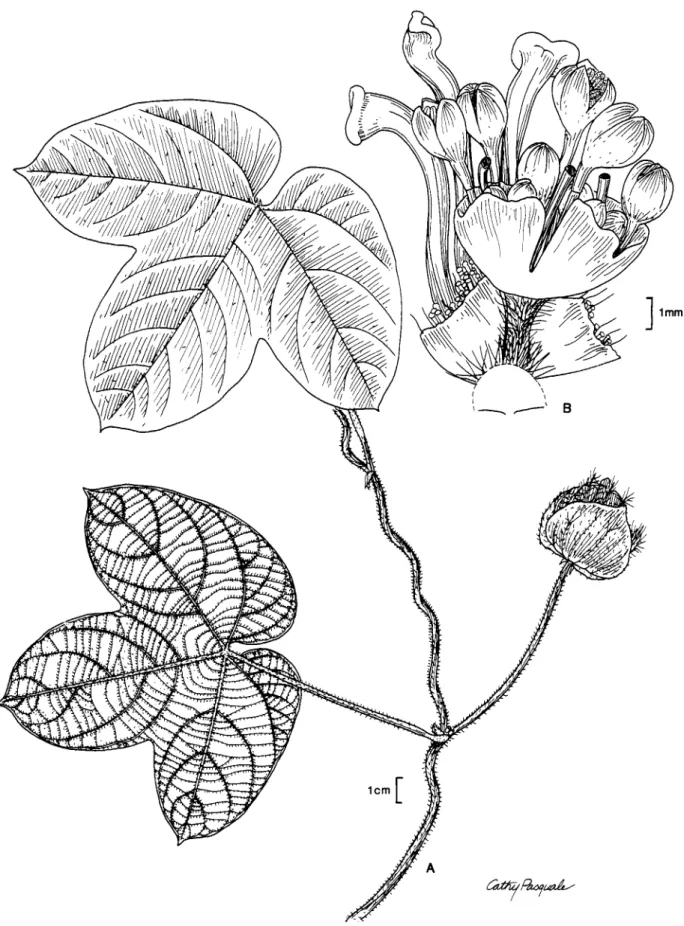
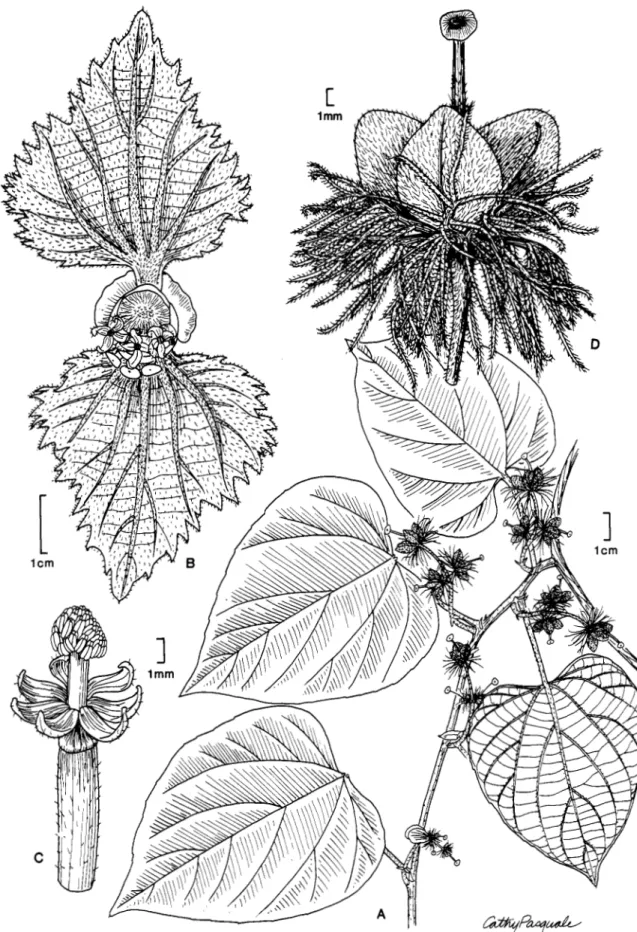
![FIGURE I3.-Tragia fendleri Muell. Arg. and Tragia lessertiana (Bail].) Muell. Arg. A-D,G, T fendleri: A, habit;](https://thumb-ap.123doks.com/thumbv2/123dok/11138649.0/42.918.154.754.90.986/figure-tragia-fendleri-muell-tragia-lessertiana-muell-fendleri.webp)